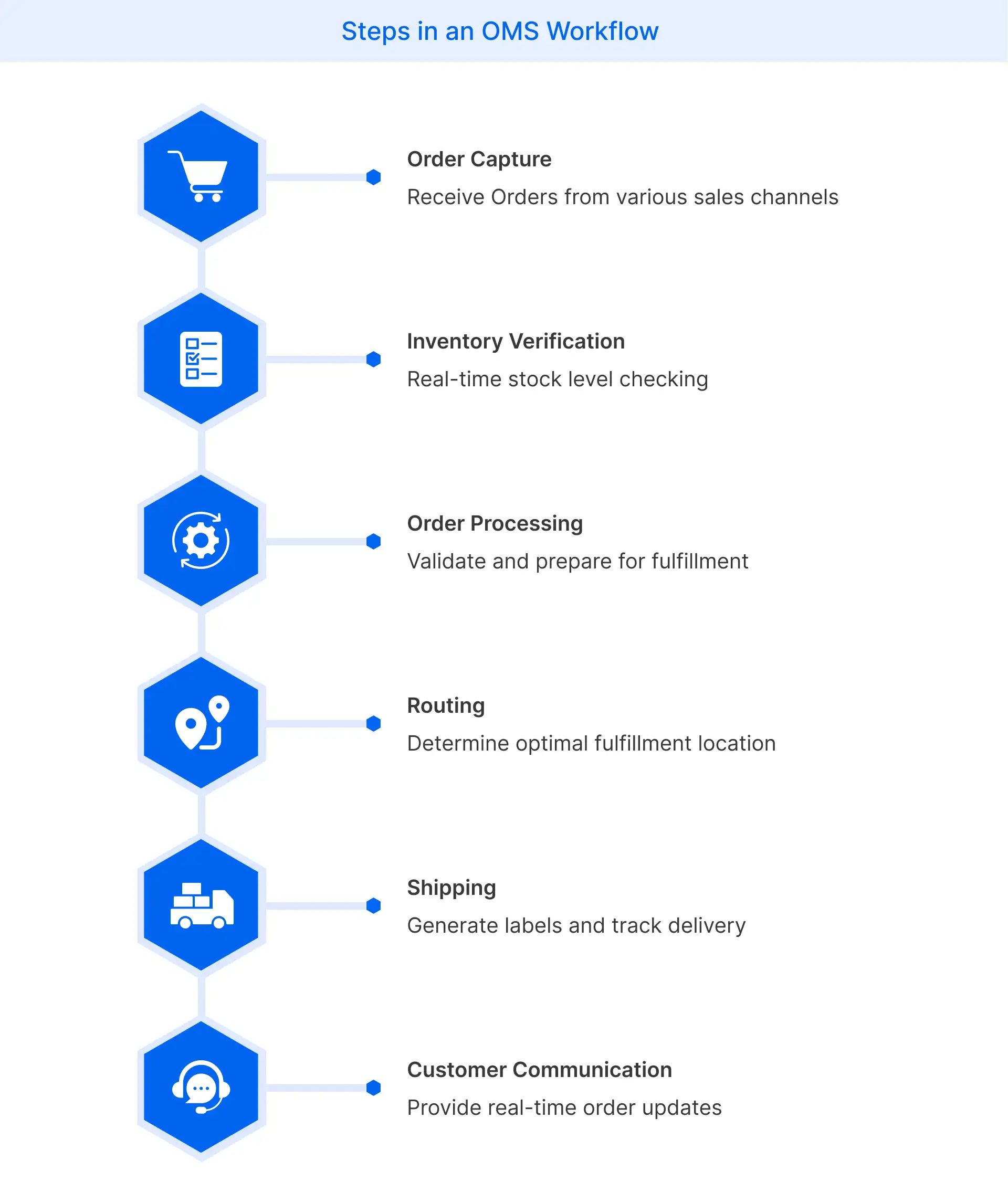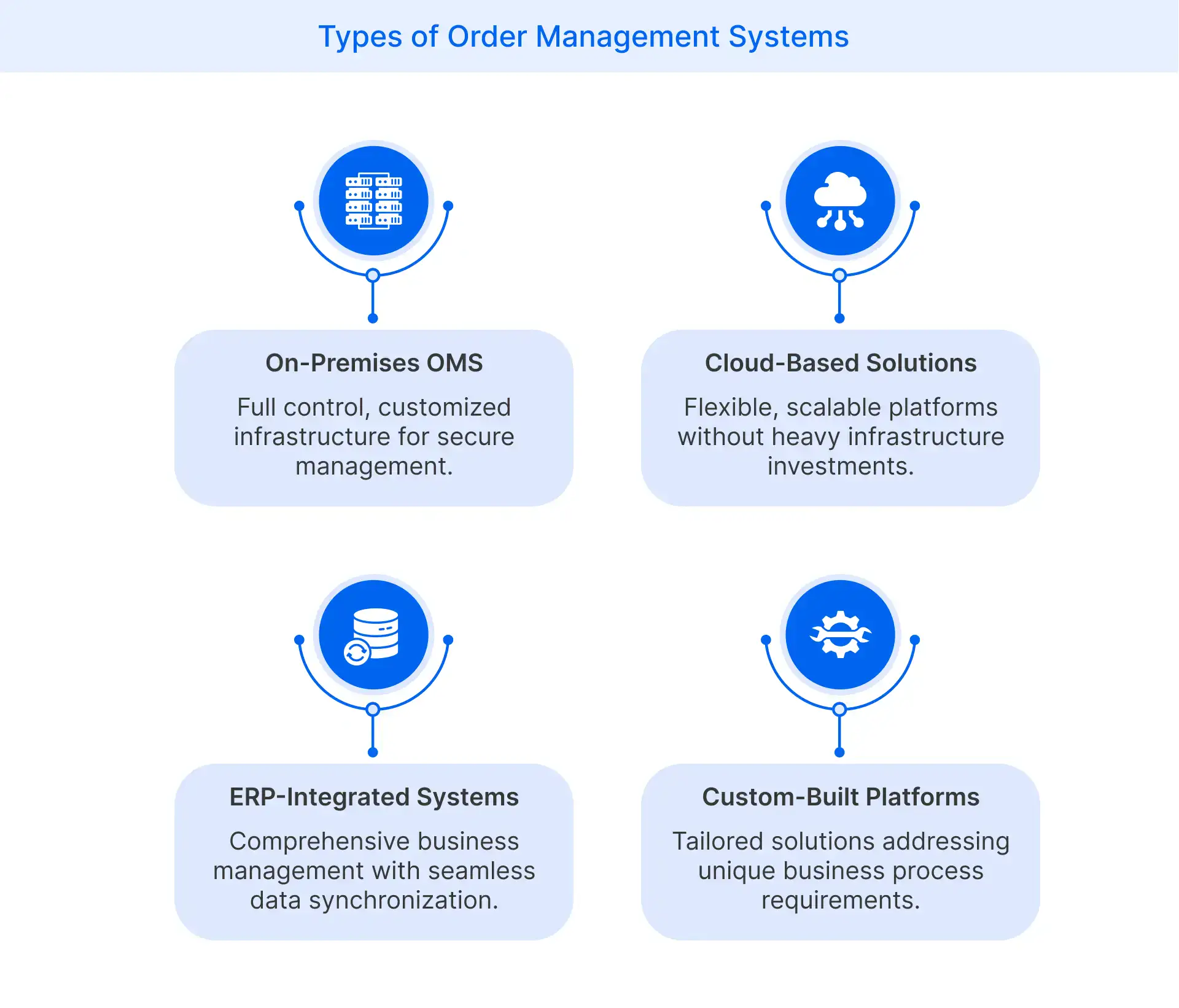Table of Contents
- What is an Order Management System?
- Core Features of an Order Management System
- Types of Order Management Systems
- What Are the Benefits of Using an Order Management System?
- How to Select the Right Order Management System?
What is an Order Management System?
An Order Management System (OMS) is an advanced digital platform that streamlines how companies handle sales processes across multiple channels. It centralizes order entry, inventory management, order routing, and customer communication, transforming complex retail operations into efficient workflows.
Modern retailers leverage OMS technology to gain comprehensive real-time visibility across their entire supply chain. The system provides instant access to critical data on inventory levels, order status, and customer data across ecommerce business platforms, mobile devices, and physical stores. This visibility enables precise demand forecasting, reduces stockouts, and facilitates seamless fulfillment of orders.
By integrating inventory, payment, and shipping systems, an OMS empowers businesses to deliver exceptional customer experiences through accurate delivery promises, transparent order tracking, and responsive service..

Core Features of an Order Management System
By integrating the following features, an OMS empowers businesses to optimize their entire order fulfillment ecosystem:
Real-Time Inventory Visibility
Modern retailers require instantaneous insights into stock levels across diverse sales platforms. An advanced Order Management System provides comprehensive, dynamic inventory tracking that synchronizes data in milliseconds, enabling businesses to make informed decisions about stock allocation and prevent potential overselling scenarios in both online and retail store environments.
Order Orchestration and Routing
Intelligent OMS solutions leverage sophisticated algorithms to determine the most efficient order fulfillment strategy. By analyzing multiple variables, such as the proximity of distribution centers, inventory availability, shipping costs, and predefined business rules, these systems automatically select the optimal routing path, minimizing both delivery times and operational expenses.
Returns Management Functionality
Streamlined returns processing is critical to customer satisfaction and operational efficiency. A robust Order Management System automates the entire returns workflow, from initial customer request through inventory reintegration, ensuring rapid processing, accurate tracking, and seamless financial reconciliation with minimal manual intervention.
Channel Integration Capabilities
Successful omnichannel retail strategies demand flawless data synchronization across multiple sales platforms. An effective order management software acts as a central nervous system, connecting e-commerce websites, mobile apps, physical stores, and marketplace channels to maintain consistent product catalog representations. This helps eliminate data discrepancies even for businesses operating on a single platform.
Analytics and Reporting Tools
Comprehensive OMS analytics make data-driven decision-making possible. These advanced tools transform raw transactional data into actionable insights, enabling businesses to forecast demand trends, identify performance bottlenecks, optimize inventory strategies, and develop targeted marketing approaches that drive sustainable growth in supply chain operations.
Types of Order Management Systems
Order Management Systems (OMS) have evolved to meet diverse business needs, offering multiple deployment models that cater to different organizational strategies, technological capabilities, and operational requirements.
On-Premises Order Management Systems
Traditional on-premises OMS represents a classic approach to software deployment, where businesses host and manage the entire system within their own technological infrastructure. These solutions provide maximum control and customization, allowing companies to maintain complete oversight of their order management processes and data security.
Cloud-Based Order Management Solutions
Software-as-a-Service (SaaS) OMS platforms revolutionize order management by offering unprecedented flexibility and scalability. These cloud-native solutions eliminate significant upfront infrastructure investments, providing businesses with adaptive technologies that can quickly scale to process orders as order volumes change to meet market demands and operational complexities.
ERP-Integrated Order Management Systems
Enterprise Resource Planning (ERP) systems with embedded order management functionality create a comprehensive business management ecosystem. These integrated solutions synchronize order processing with financial management, inventory control, and customer relationship systems, enabling seamless data flow and holistic business intelligence.
Custom-Built Order Management Platforms
Specialized businesses with unique operational requirements can leverage custom-developed Order Management Systems tailored to their specific workflows. These bespoke solutions address intricate business processes, providing precise functionality that off-the-shelf platforms cannot accommodate, ensuring maximum operational efficiency and strategic alignment.

What Are the Benefits of Using an Order Management System?
The strategic implementation of a new OMS delivers comprehensive advantages that extend far beyond traditional order processing capabilities:
- Operational Efficiency Optimization: Businesses can dramatically streamline their order workflows by eliminating manual processes and automating complex operational tasks. An intelligent OMS reduces administrative overhead, allowing teams to focus on strategic growth initiatives and customer-centric activities.
- Enhanced Order Accuracy and Precision: Sophisticated OMS platforms minimize human error through automated validation and tracking mechanisms. By ensuring accurate order processing, businesses can significantly reduce costly mistakes, returns, and customer dissatisfaction through improved quality control.
- Workforce Productivity Transformation: Advanced order management technologies eliminate manual data entry and repetitive administrative tasks. Employees can redirect their efforts towards higher-value activities that drive business innovation and improve overall organizational performance.
- Accelerated Fulfillment Capabilities: Intelligent routing and real-time inventory management enable businesses to expedite order processing and shipping. Faster fulfillment directly translates to improved customer satisfaction and competitive advantage in the rapidly evolving retail landscape.
- Elevated Customer Experience: A comprehensive OMS provides seamless, transparent order tracking and consistent communication across multiple sales channels. By delivering exceptional customer interactions, businesses can build long-term loyalty and differentiate themselves in competitive markets.
How to Select the Right Order Management System?
Selecting an appropriate Order Management System requires a strategic, methodical approach that aligns technological capabilities with specific business objectives.
Assessing Your Current Order Management Challenges
Conduct a comprehensive audit of existing order processing workflows to identify inefficiencies, bottlenecks, and pain points. Engage cross-functional teams to gather insights into operational limitations and potential improvement areas.
Defining Technical Requirements and Integration Needs
Develop a detailed technical specification that outlines essential system integrations, compatibility with existing infrastructure, and specific functional requirements. Consider the unique technological ecosystem of your business when defining these parameters.
Evaluating Vendor Capabilities and Support Services
Investigate potential modern OMS providers through a multifaceted evaluation process. Assess their industry expertise, implementation methodologies, ongoing support capabilities, and track record of successful deployments in similar business contexts
Considering Scalability and Future Business Growth
Select an OMS that offers flexible architecture capable of adapting to evolving business models and market dynamics. Prioritize solutions that can seamlessly scale and accommodate future technological advancements and organizational expansion.
Calculating Total Cost of Ownership and ROI
Perform a comprehensive financial analysis that extends beyond initial implementation costs. Consider long-term expenses, potential efficiency gains, and projected return on investment to make an informed decision.
FAQ
Small businesses can significantly leverage Order Management Systems to streamline operations and compete more effectively in the digital marketplace. An OMS provides scalable solutions that automate complex order processes, reduce manual errors, and create professional, efficient workflows that support business growth and customer satisfaction.
While inventory management software focuses primarily on tracking stock levels and quantities, an Order Management System offers a comprehensive approach to the entire order lifecycle. OMS integrates inventory tracking with order processing, customer communication, fulfillment routing, and comprehensive analytics, providing a more holistic business management solution.
Even single-platform sellers can benefit from an Order Management System by improving operational efficiency, reducing manual work, and enhancing customer experience. An OMS provides advanced features like automated order processing, real-time tracking, and detailed reporting that can help small businesses optimize their operations and prepare for future growth.
Modern Order Management Systems are designed to handle complex returns and reverse logistics processes comprehensively. These systems automate return authorization, track return shipments, manage inventory reintegration, process refunds, and provide detailed analytics about return patterns, helping businesses improve their overall customer service and operational efficiency.

